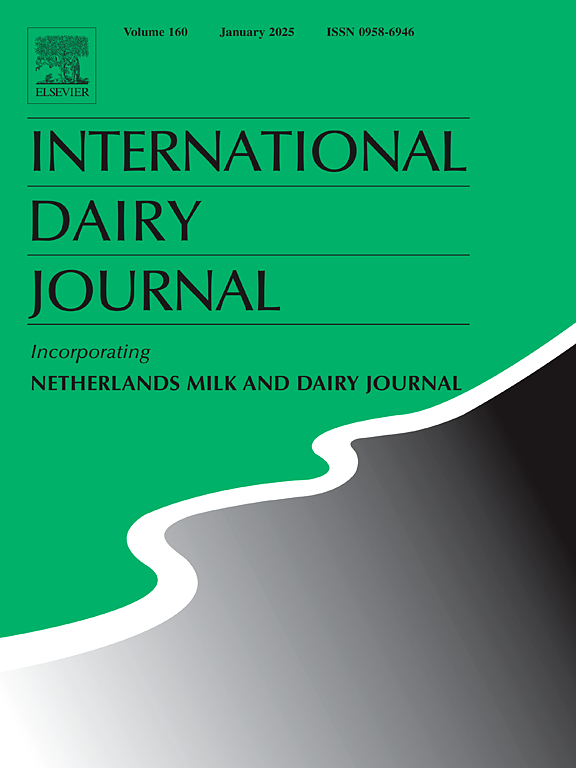Impact of native Enterococcus faecalis and Pichia kudriavzevii intracellular enzymes on ultra-filtered cheese: compositional, textural and sensory analysis
IF 3.4
3区 农林科学
Q2 FOOD SCIENCE & TECHNOLOGY
引用次数: 0
Abstract
This study aimed to expedite the ripening process of ultra-filtered (UF) cheese utilizing intracellular crude enzymes (CRE) derived from native enterococci and yeasts. Model UF cheese samples were treated with the CRE of selected strains, showcasing both proteolytic and lipolytic activities. The cheeses underwent comprehensive analysis for proteolytic, lipolytic, textural, and sensory characteristics over a 60-day storage period. From the microbial isolates obtained from Lighvan cheese, a subset of 7 Enterococcus and 7 yeast strains were chosen for further characterization. Results revealed a progressive increase in proteolysis and lipolysis indices across all groups including cheese supplemented with Enterococcus faecalis CRE (E-C), cheese supplemented with Pichia kudriavzevii CRE (P-C), cheese supplemented with a combination (1:1) of both E. faecalis and P. kudriavzevii CRE (E.P-C), cheese supplemented with commercial enzymes (CE-C) and control cheese without enzyme supplementation (C-C) during storage. Notably, cheeses inoculated with the combination of Enterococcus faecalis and Pichia kudriavzevii CRE exhibited superior sensory attributes compared to those treated with individual CRE or commercial enzymes. In conclusion, the synergistic action of E. faecalis and P. kudriavzevii CRE emerges as a promising strategy for enhancing flavor, texture, and the ripening process of UF cheese.
粪肠球菌和毕赤酵母胞内酶对超滤奶酪的影响:成分、质构和感官分析
本研究旨在利用来自天然肠球菌和酵母的细胞内粗酶(CRE)加速超滤(UF)奶酪的成熟过程。用所选菌株的CRE处理UF模型奶酪样品,显示出蛋白水解和脂解活性。在60天的储存期内,对这些奶酪进行了蛋白质水解、脂肪水解、质地和感官特征的综合分析。从从Lighvan奶酪中获得的微生物分离株中,选择7株肠球菌和7株酵母菌进行进一步鉴定。结果表明,粪肠球菌CRE (E-C)组、库德里亚夫zevii毕赤酵母CRE (P-C)组、粪肠球菌CRE和库德里亚夫zevii CRE (e.p. - c)组合(1:1)组、添加商业酶(CE-C)组和未添加酶(C-C)的对照奶酪在贮藏期间的蛋白水解和脂肪分解指数均呈逐渐升高趋势。值得注意的是,与单独接种CRE或商用酶的奶酪相比,粪肠球菌和毕赤酵母CRE联合接种的奶酪表现出更好的感官特性。综上所述,粪肠杆菌和P. kudriavzevii CRE的协同作用有望改善UF奶酪的风味、质地和成熟过程。
本文章由计算机程序翻译,如有差异,请以英文原文为准。
求助全文
约1分钟内获得全文
求助全文
来源期刊

International Dairy Journal
工程技术-食品科技
CiteScore
6.50
自引率
9.70%
发文量
200
审稿时长
49 days
期刊介绍:
The International Dairy Journal publishes significant advancements in dairy science and technology in the form of research articles and critical reviews that are of relevance to the broader international dairy community. Within this scope, research on the science and technology of milk and dairy products and the nutritional and health aspects of dairy foods are included; the journal pays particular attention to applied research and its interface with the dairy industry.
The journal''s coverage includes the following, where directly applicable to dairy science and technology:
• Chemistry and physico-chemical properties of milk constituents
• Microbiology, food safety, enzymology, biotechnology
• Processing and engineering
• Emulsion science, food structure, and texture
• Raw material quality and effect on relevant products
• Flavour and off-flavour development
• Technological functionality and applications of dairy ingredients
• Sensory and consumer sciences
• Nutrition and substantiation of human health implications of milk components or dairy products
International Dairy Journal does not publish papers related to milk production, animal health and other aspects of on-farm milk production unless there is a clear relationship to dairy technology, human health or final product quality.
 求助内容:
求助内容: 应助结果提醒方式:
应助结果提醒方式:


